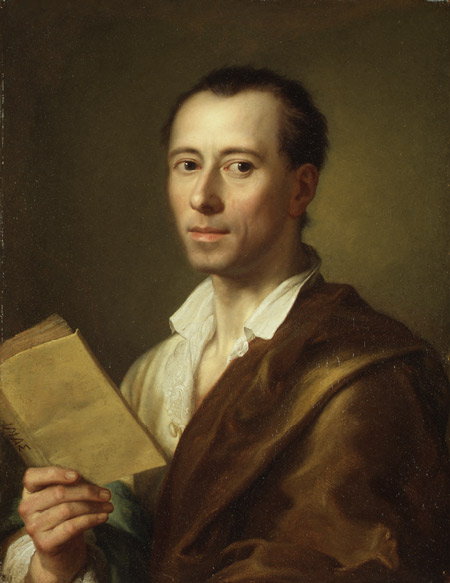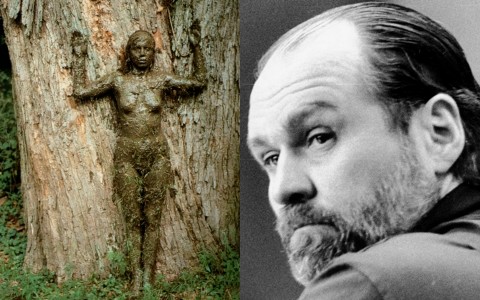Wednesday, November 21st, 2012
Art History and Murder!
“Murder can be an art, too.” – Alfred Hitchcock’s film Rope (1948)
________________________________________________________________
When I was a kid, I used to watch rerun episodes of “Perry Mason” on TV all the time. Maybe that series initially sparked my interest in murder mysteries. Even now, as an adult, I still like to read detective stories and watch murder mystery shows. Lately I’ve been coercing my husband to watch episodes from the fourth season of “The Mentalist” almost every night. I guess “The Mentalist” is my modern version of “Perry Mason.”
Anyhow, I thought it would be fun to write a post on art history topics that involve murder. I’m not necessarily interested in depictions of murder, though. Gruesome depictions of murder are commonplace (yawn!) in art, including David’s famous Death of Marat shown above. Instead, I thought it would be interesting to discuss when artists or art historians have been murdered, committed murder, or accused of murder. These were the three cases that came to my mind:
1) In 1606, the volatile painter Caravaggio killed Ranuccio Tomassini. The pretext for the duel had to do with a tennis match, but art historian Andrew Graham-Dixon believes that these two men were really fighting over a prostitute. Graham-Dixon believes that Caravaggio was attempting to castrate Tomassini, since Tomassini bled to death from a femoral artery in his groin.
But Caravaggio’s associations with murder go even further. It is also thought that Caravaggio himself was murdered. While on the run from his murder conviction, Caravaggio fled to Malta and then Porto Ercole (Italy). Scholars think that Caravaggio was murdered either by relatives of Tomassoni or by the Knights of Malta (or at least one knight from Malta). The latter theory is suggested because it appears that Caravaggio was convicted of inflicting bodily harm on a noble knight in Malta. The knight (with or without his fellow knights) may have pursued Caravaggio and killed him.1
2) This murder story is probably one of the least expected, I think. The 18th century art historian Johann Joachim Winckelmann, who is best known for his studies on Greek sculpture and open homosexuality, was murdered in 1768. After visiting Vienna (and being received by the Empress Maria Theresa), Winckelmann stopped at a hotel in Trieste on his way back to Rome. At that point, he was murdered at the hotel by a man named Franceso Arcangeli. Winckelmann was showing coins that had been presented to him by the Empress Maria Theresa, so it is possible that the motive for murder was monetary. However, Professor Alex Potts has mentioned other possible reasons for murder (including conspiracy or a sexual motive). Potts also explored how Winckelmann’s murder affected scholarship (both Winckelmann’s own scholarship and a later interest in the deceased art historian’s work).2
3) This murder story involves not one, but two, 20th century artists. In 1985 the performance artist Ana Mendieta (depicted above on the left) fell 34 stories to her death, falling from her apartment in Greenwich Village (in New York). The only other person who was with Mendieta at the time of her death was her husband of eight months: Carl Andre, the minimalist sculptor. Andre was charged with second-degree murder, but was acquitted after a three-year struggle in the court system. Art in America claims that evidence was suppressed in the trial, due to sloppy work on the part of the police and prosecutors.
The turbulent relationship between this couple has been turned into a play, “Performance Art in Front of the Audience Ought to be Entertaining.” The play is set on the night that Ana was murdered, but the curtain falls before Ana actually dies – in other words, the theatergoer is left to decide what happened right before Ana died.
Okay, now it’s your turn. Do you know of other artists or art historians who have been involved with murder cases?
1 The death of Caravaggio is explored by Andrew Graham-Dixon in his book Caravaggio andin his BBC documentary, “Who Killed Caravaggio?” Watch Part 1, Part 2, Part 3, Part 4, and Part 5 on YouTube.
2 Alex Potts and Joahann Joachim Winckelmann, History of the Art of Antiquity: Texts and Documents (Los Angeles: Getty Research Institute, 2006), p. 15-15. Text available online HERE.




Walter Sickert was an artist who was accused, amongst others, of being Jack the Ripper. Even if Sickert was not the real murderer, he certainly had a great personal interest in prostitutes and he showed a lot of interest in the Ripper case.
Why would an artist be nominated as a mass murderer of women? He painted some pretty grotty bedrooms and their sleazy occupants. The murders, from 1888-91, were in his streets and one of his works really was called Jack the Ripper’s Bedroom.
In Portugal, in 1900, there is also a murder story. A female artist, Josefa Greno, killed her husband, also a painter, Adolfo Greno. She was arrested at a psychiatric hospital until she died, few years later.
There’s a catchy title for you. 🙂 Didn’t Walter Benjamin die under mysterious circumstances?
Croatian painter Josip Račić was found dead in his Paris hotel room in 1908. The cause of death was a gunshot wound. It hasn’t been determined with certainty whether it was suicide or murder. He was 23 years old, had arrived in Paris only a few months earlier, after a stint in the Munich Academy where he had studied with a group of young Croatian painters. This group is referred to as ‘Munich Circle’ in the Croatian art history and is considered the pioneering force of our modernism.
Edward Muybridge–he of the famous motion studies–shot and killed his wife’s lover, Major Harry Larkyns. The jury acquitted him, saying it was justifiable homicide. More details here: http://en.wikipedia.org/wiki/Eadweard_Muybridge#Murder.2C_acquittal_and_paternity
Ben
Thanks for all of the comments, everyone! These are all very interesting. I’m intrigued by Walter Sickert and the Jack the Ripper story, Hels. I have to admit, though, the Edward Muybridge comment by Ben surprised me the most! I had no idea that Muybridge was acquitted of the murder of his wife’s lover. What drama!
@heidenkind, I had no idea that there was controversy surrounding the death of Walter Benjamin, either. I found a little bit more information about the circumstances on this site. One conspiracy theory is that Benjamin was killed by Stalinist agents:
http://walterbenjaminportbou.cat/en/content/el-darrer-passatge
Another individual that I thought we could perhaps add to this list in Mary Pinchot Meyer. She was a mistress of JFK, and also a painter. I’m not familiar with her work (I can’t find examples of it online), and I’m not sure how actively she was involved in the artistic scene – beyond the fact that she was friends with Kenneth Noland. But I do know that she allegedly finished a painting in her studio, went out for for a walk, and subsequently was murdered on October 12, 1964.
Ben shared another one with me on Twitter: The English 19th-century painter Richard Dadd murdered his father, having been convinced that his father was the Devil. Dadd suffered from a form of schizophrenia and was later committed to a psychiatric hospital (but not before he attempted to kill a tourist, whom he encountered in France after fleeing from his first murder).
Dadd also spoke of killing the pope and emperor of Austria. See here:
http://www.getty.edu/art/gettyguide/artMakerDetails?maker=281
Another one! The Brazilian 19th-century painter José Ferraz de Almeida Júnior was killed at the age of fifty. Almeida Júnior was having an affair with the wife of his cousin. In a fit of rage, his cousin stabbed Almeida Júnior to death outside the Hotel Central in Piracicaba.
Thank you M for this morbid but fascinating post!
The other example that comes to mind was the murder reported by Vasari – who tells us Andrea del Castagno killed fellow painter Domenico Veneziano. Researchers have since demonstrated that Veneziano died *after* del Castagno, so we are left scratching our heads at what Vasari was alluding to, or whether he was simply trying to spice up his book at del Castagno’s expense.
H
There’s also a new theory that Van Gogh was murdered, because his gunshot wound was at a totally weird angle compared to what is generally self-inflicted. But obviously, it’s all speculation!
Thanks for your comments, Hasan and Shelly!
Although I really appreciate Vasari, I’m not surprised to learn that there is another inaccuracy in his influential book. I wonder if that misinformation about del Castagno was intentional.
Shelly, I haven’t heard that theory about Van Gogh! That’s interesting. A few years ago I posted about another gruesome speculation regarding Van Gogh: there is theory that Van Gogh’s ear was actually cut off by Gauguin.
I just thought of another one, although this is more of an attempted murder. When Bernini suspected that his brother was involved with Costanza Bonarelli (Bernini’s girlfriend), Bernini tried to kill his brother. Bernini badly beat his brother with an iron bar and broke a few of his ribs. Then, Bernini ordered his servant to slash Costanza’s face with a razor.